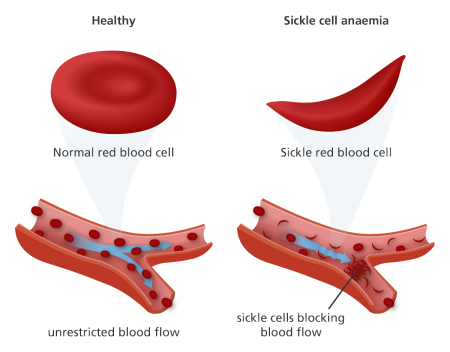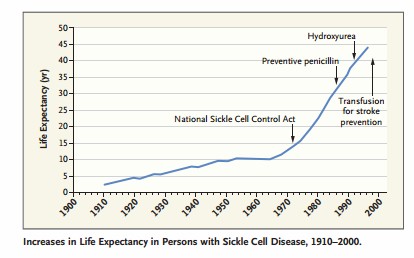March 6, 2017 – In the March 2nd edition of The New England Journal of Medicine, an article entitled, Gene Therapy in a Patient with Sickle Cell Disease, describes the use of genetic engineering to treat a disease, that along with thalassemia, is genetically inherent in 5% of the world’s population. Today more than 275,000 are born with sickle-cell disease, a condition where abnormal hemoglobin distorts red blood cells, turning them from a normal donut shape, into cells that look like a sickle.
Not only are these cells misshaped, they are also inelastic. That latter characteristic makes them dangerous because they can block blood vessels and impair flow. The end result is blood cells less capable of carrying oxygen leading to anemia. Anemia makes sickle-cell disease sufferers more susceptible to infections and necrosis (tissue death). It also decreases life expectancy, which with the best medicine can offer today, is between 40 and 60.
In the United States today, 100,000 people have the disease with most African-American. One in every 365 black children in the country has the disease inheriting from parents who both carry the mutation. Other than the U.S., the sickle-cell trait can be found in Africa and in the Mediterranean. Conventional treatment does not provide a cure. Periodic red blood cell transfusions allay the worst symptoms. Pain killers help as well, and antibiotics can treat infections. But the only current long-term relief is bone marrow transplants.
Genetic engineering, however, may prove to be life altering for sickle cell anemia sufferers. At Necker Children’s Hospital in Paris, a 13-year old patient received had bone marrow extracted to harvest stem cells and alter the genetic code to make normal hemoglobin. The patient received chemotherapy to eliminate all stem cells carrying the faulty genes responsible for the disease. Then the harvested and treated stem cells were reintroduced. These modified stem cells started churning out healthy red blood cells.
About the patient who underwent the therapy, Dr. Philippe Leboulch, Professor of Medicine, University of Paris, states, “Since therapy was applied, he hasn’t had any pain, any complications. He is free of any transfusions. He plays sports and goes to school.” Senior author of the study and head of the Biotherapy Department at Necker states, “all the biological tests we perform lead us to think he is cured.”
Leboulch and colleagues are also experimenting with this therapy to treat thalassemia, the other inherited blood disorder that produces low red blood cell levels requiring numerous blood transfusions.
A companion clinical trial employing the same therapy is underway in the United States with seven patients being treated. Ultimately the goal would be to introduce the therapy shortly after birth when the disease is first identified. That would mean fewer issues to overcome as the people with the disease suffer complications.


















[…] Can Genetic Engineering Cure Sickle Cell Anemia? – March 6, 2017 – In the March 2nd edition of The New England Journal of Medicine … Genetic engineering, however, may prove to be life altering for sickle cell anemia sufferers. At Necker Children’s Hospital in … […]
[…] Can Genetic Engineering Cure Sickle Cell Anemia? – March 6, 2017 – In the March 2nd edition of The New England … The end result is blood cells less capable of carrying oxygen leading to anemia. Anemia makes sickle-cell disease sufferers more susceptible to … […]
[…] Can Genetic Engineering Cure Sickle Cell Anemia? – The end result is blood cells less capable of carrying oxygen leading to anemia. Anemia makes sickle-cell disease sufferers more susceptible to infections and necrosis (tissue death). It also decreases life … […]
[…] Can Genetic Engineering Cure Sickle Cell Anemia? – Genetic engineering, however, may prove to be life altering for sickle cell anemia sufferers. At Necker Children’s … after birth when the disease is first identified. That would mean fewer issues to overcome as the people … […]